75 Best Short Stories for High School Students
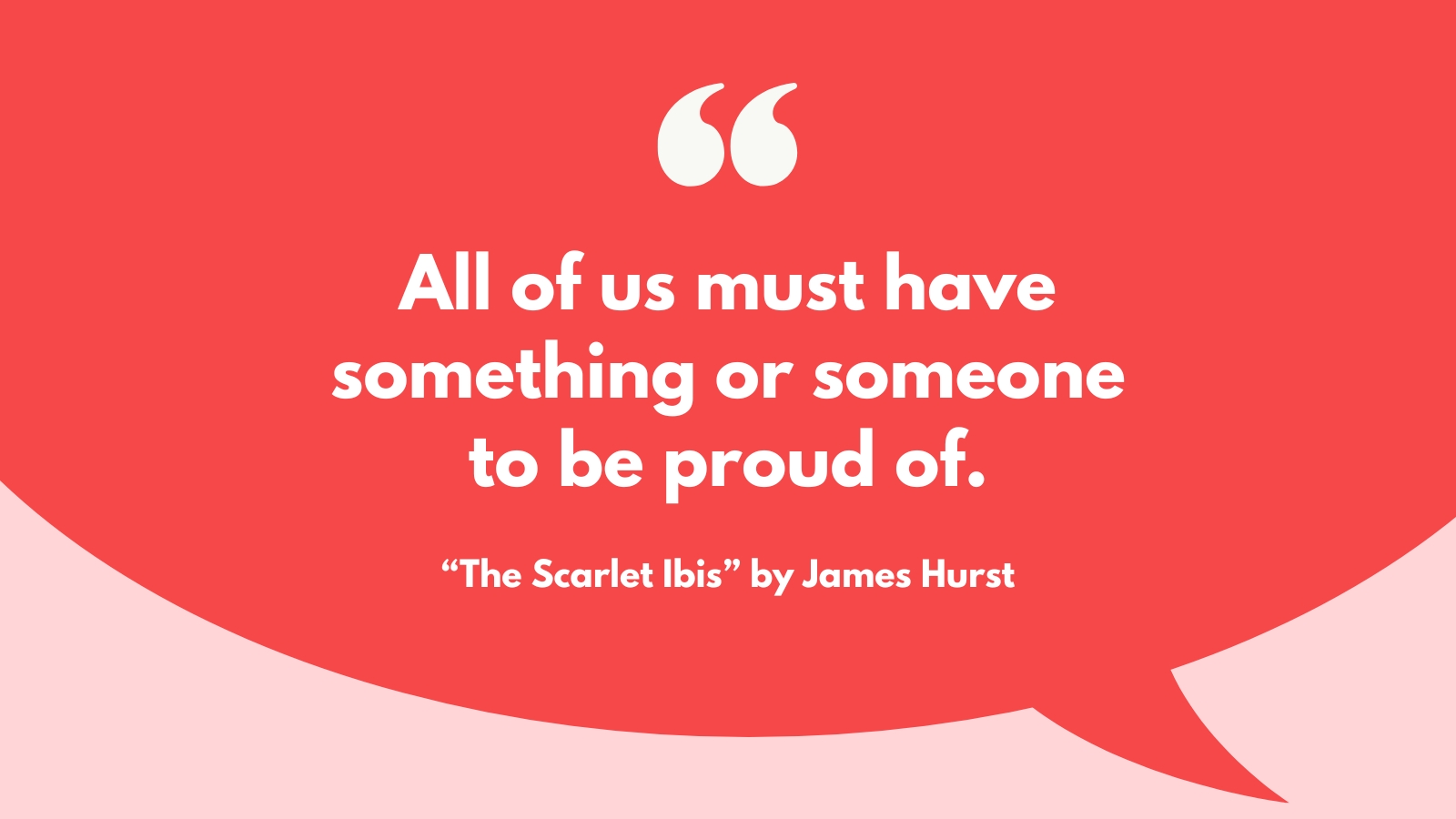
Short stories are so fun to teach in high school. First, high schoolers are ready and able to dive deep into text with close reading and analysis, which makes reading and analyzing short stories fun. Second, high schoolers love to read texts that pack an emotional punch, which is short stories all the way. Use these short stories to teach close reading, literary devices, as mentor texts for writing and to surprise students and engage them in reading.
1. Lamb to the Slaughter by Roald Dahl
“‘I’ll fix some supper,’ she whispered. When she walked across the room, she couldn’t feel her feet touching the floor….She went downstairs to the freezer and took hold of the first object she found. She lifted it out, and looked at it. It was wrapped in paper, so she took off the paper and looked at again—a leg of lamb.
Why we love it: Students may already know Roald Dahl from Charlie and the Chocolate Factory, Matilda, and other whimsical novels. But, this short story will challenge their opinion of Dahl. Encourage students to analyze the dramatic irony and discuss: Who is the innocent lamb in this story?
2. The Most Dangerous Game by Richard Connell*
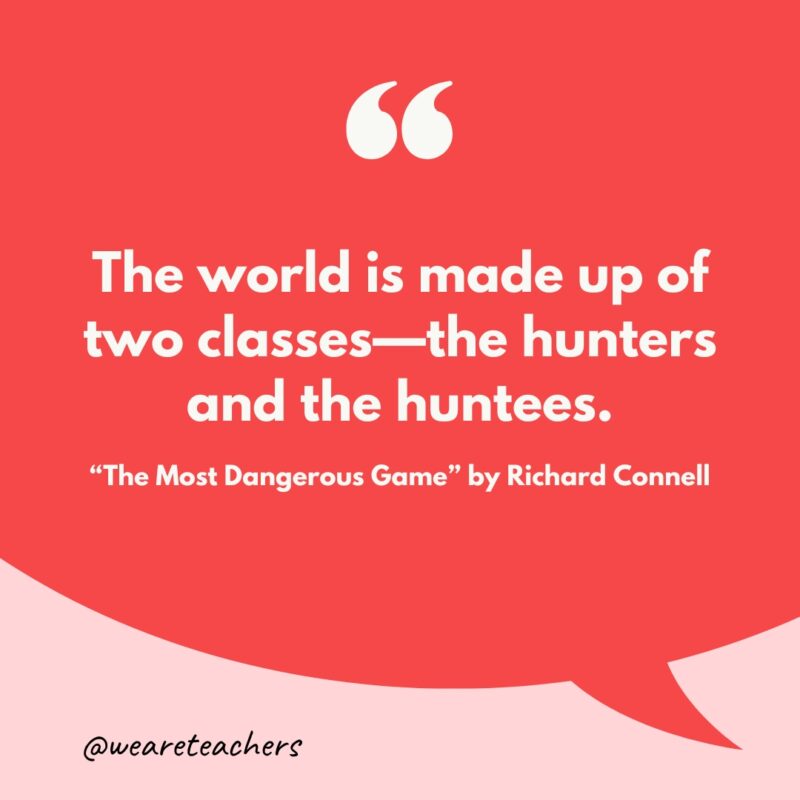
Why we love it: This is one of those short stories for high school that engages all students. Ask them: What is the most dangerous game in the world? Then, do a close reading of this story to figure out what’s happening as the story unfolds.
3. The Landlady by Roald Dahl
“‘I stuff all my little pets myself when they pass away. Will you have another cup of tea?’”
Why we love it: This story is great for suspense, irony, and characterization. It always creeps students out.
4. All Summer in a Day by Ray Bradbury*
“I think the sun is a flower / That blooms for just one hour.”
Why we love it: This story is heartbreaking and truth-telling. Bradbury takes us to Venus and uses the setting to drive the conflict and focus on the character’s behavior.
5. The Veldt by Ray Bradbury
“Too much of anything isn’t good for anyone.”
Why we love it: It’s a dystopian story about the power of technology in our lives. Need we say more? Read this story to start a discussion about technology in our lives, how fiction writing connects with real life, and how science fiction in particular can feel prophetic.
6. The Lottery by Shirley Jackson
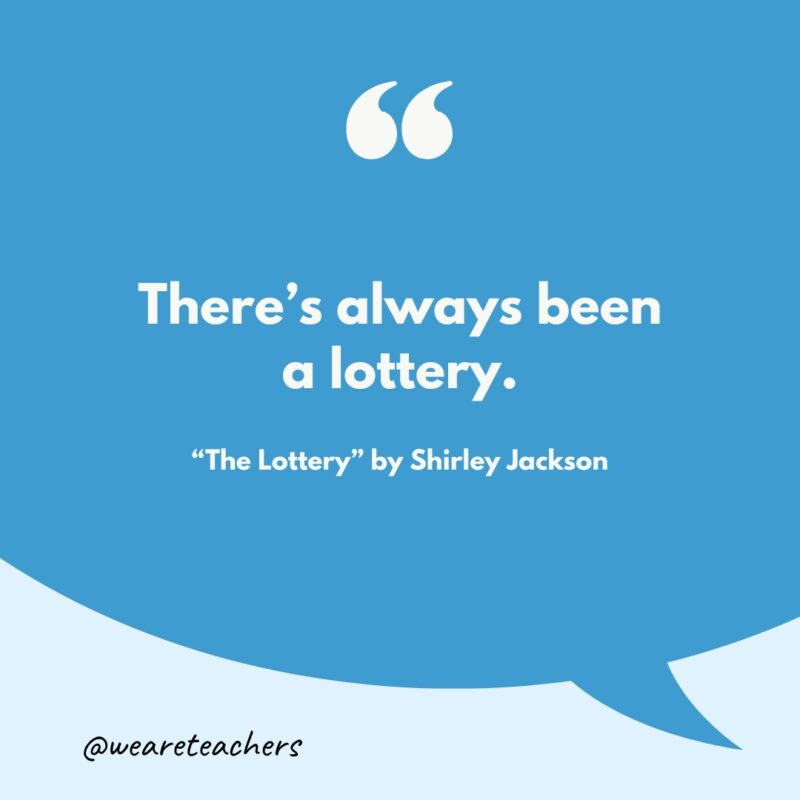
Why we love it: The brutality of this story sneaks up on you. For a while, you’re convinced this town is ordinary until you find out the dark consequences of blindly following tradition. This is a must-read for high schoolers, even if they’re read it before, coming to this story from a new perspective will give them even more to reflect on and discuss.
7. The Tell-Tale Heart by Edgar Allan Poe*
“It is impossible to say how first the idea entered my brain; but once conceived, it haunted me day and night.”
Why we love it: My students love a murder mystery. This one is made even more alluring while the narrator tries to convince the readers of his sanity.
8. The Gift of the Magi by O. Henry
“The James Dillingham Youngs were very proud of two things which they owned. One thing was Jim’s gold watch. … The other thing was Della’s hair.”
Why we love it: It’s one of the best stories for high school to teach irony during the holiday season.
9. The Monkey’s Paw by W.W. Jacobs*
“Never mind, dear,” said his wife soothingly; perhaps you’ll win the next one.”
Why we love it: One of the classic short stories for high school about what can go wrong when granted three wishes. Students also love to know that there was a Simpsons episode based on this short story.
ADVERTISEMENT
10. The Hanging Stranger by Philip Dick
“Again he made a U-turn and brought his car around. He passed the park and concentrated on the dark bundle. It wasn’t a dummy. And if it was a display it was a strange kind. The hackles on his neck rose and he swallowed uneasily. Sweat slid out on his face and hands.
It was a body. A human body.”
Why we love it: An average television repairman finds a dead body and a mystery ensues. This story is best read with some historical context (at the time it was written lynchings were common) and people were living in an age of conformity. But, with context, students can understand this story as one of resistance against capitalism.
11. The Ones Who Walk Away From Omelas by Ursula K. LeGuin
“This is the treason of the artist: a refusal to admit the banality of evil and the terrible boredom of pain.”
Why we love it: In a much-praised story, students read about a utopia built on others’ suffering and grapple with the question if they, too, would walk away from happiness.
12. Araby by James Joyce*
“Her name sprang to my lips at moments in strange prayers and praises which I myself did not understand. My eyes were often full of tears (I could not tell why) and at times a flood from my heart seemed to pour itself out into my bosom. I thought little of the future. I did not know whether I would ever speak to her or not or, if I spoke to her, how I could tell her of my confused adoration.”
Why we love it: It’s about growing up and developing a crush that is all-consuming, which high schoolers can relate to.
13. A Sound of Thunder by Ray Bradbury
“It fell to the floor, an exquisite thing, a small thing that could upset balances and knock down a line of small dominoes and then big dominoes and then gigantic dominoes, all down the years across Time. Eckels’ mind whirled. It couldn’t change things. Killing one butterfly couldn’t be that important! Could it?”
Why we love it: It’s a short story about the butterfly effect. The plot asks the question many have asked before, if we could travel back in time, how would it change the future?
14. Two Kinds by Amy Tan
“My mother believed you could be anything you wanted to be in America.”
Why we love it: It explores the complex mother-daughter relationship.
15. Rules of the Game by Amy Tan
“Next time win more, lose less.”
Why we love it: Use this for an example of extended metaphor and, what Amy Tan is known for, examining the mother-daughter relationship.
16. The Scarlet Ibis by James Hurst*
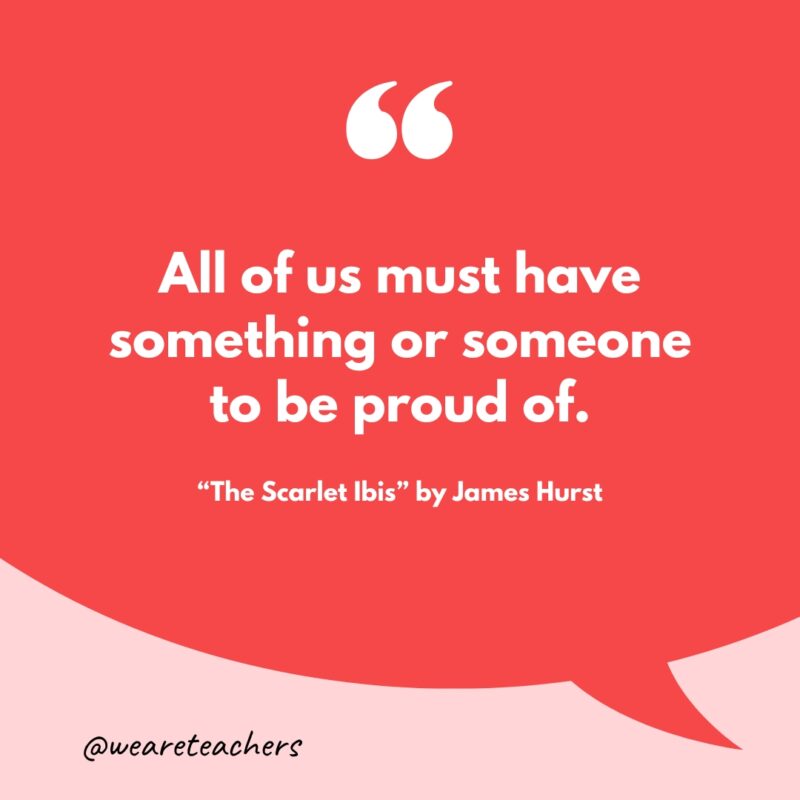
Why we love it: It’s beautifully written heartbreaking story about brothers.
17. A Good Man Is Hard To Find Flannery O’Connor
“‘It isn’t a soul in this green world of God’s that you can trust,’ she said. ‘And I don’t count nobody out of that, not nobody,’ she repeated, looking at Red Sammy.”
Why we love it: It’s a great story for studying characters, their flaws, and their transformation by the end of the story.
18. Ruthless by William de Mille
“When it comes to protecting my property, I make my own laws.”
Why we love it: It’s a tale of revenge with unexpected twists and turns.
19. The Story of an Hour by Kate Chopin*
“When the doctors came they said she had died of heart disease—of joy that kills.”
Why we love it: This 19th Century story about love and loss makes students ponder the question: Can a person die of a broken heart?
20. Eleven by Sandra Cisneros
“What they don’t understand about birthdays, and what they’ll never tell you, is that when you’re eleven, you’re also ten, and nine, and eight, and seven, and six, and five, and four, and three, and two, and one.”
Why we love it: I use this when I teach creative writing. What changes when we turn 11? How are we different from when we were 10? Most agree that it is a significant change.
21. The Test by Theodore Thomas
“Nobody should want to drive a car after going through what you just went through.”
Why we love it: Your students will not see the ending coming.
22. There Will Come Soft Rains by Ray Bradbury
“And one voice, with sublime disregard for the situation, read poetry … until all the film spools burned, until all the wires withered and the circuits cracked.”
Why we love it: Use this futuristic story to teach setting, foreshadowing, and theme.
23. The Schoolmistress by Anton Chekhov*
“‘It is beyond all understanding,’ she thought, ‘why God gives beauty, this graciousness, and sad, sweet eyes to weak, unlucky, useless people—why they are so charming.’”
Why we love it: We get to see simple moments become symbols for larger happenings in her life.
24. Lob’s Girl by Joan Aiken
“Some people choose their dogs, and some dogs choose their people.”
Why we love it: Hook students who love a good story about a dog and its owner and read it for a tale of friendship paired with elements of suspense.
25. The Occurrence at Owl Creek Bridge by Ambrose Bierce*
“He had power only to feel, and feeling was torment.”
Why we love it: With a line like this, students will be sucked into the narrative. And, the ending will shock your students.
26. The Chaser by John Collier
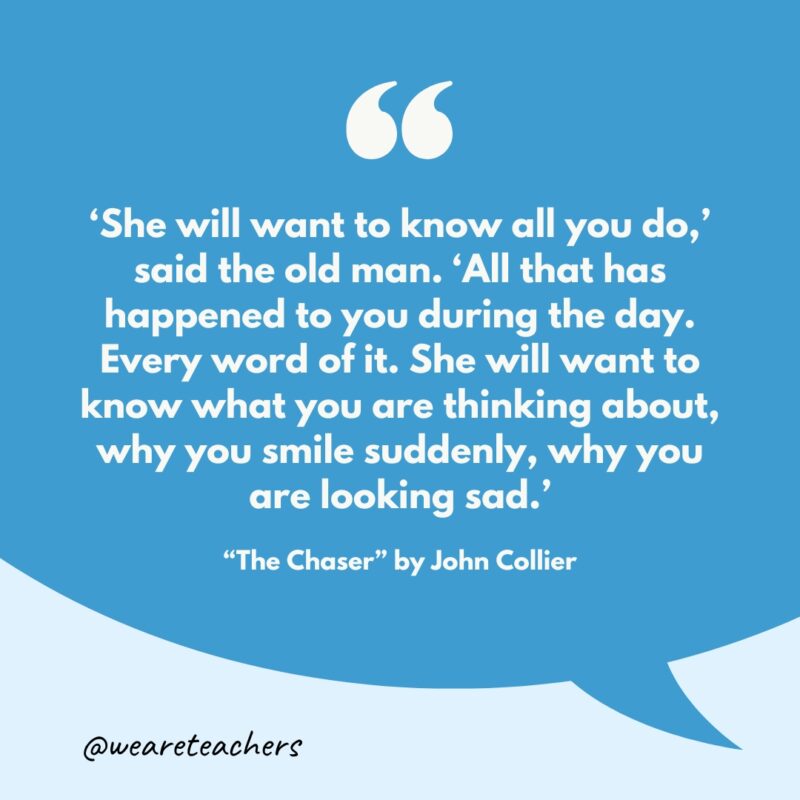
Why we love it: After you read this story, discuss: what would you be willing to do for love? Bonus: Pair with a Twilight Zone episode.
27. The Janitor in Space by Amber Sparks
“She feels at home beyond the skies. She lied and said she came here to be close to God, but she feels further away from Him than ever.”
Why weI love it: The creative plot created in this story launches deep discussion after reading.
28. Standard Loneliness Package by Charles Yu
“Root canal is one fifty, give or take, depending on who’s doing it to you. A migraine is two hundred.”
Why we love it: The plot is intriguing enough for students to be invested. Imagine a world where you outsource negative feelings and experiences to other people.
29. The Yellow Wallpaper by Charlotte Perkins Gilman*
“I cry at nothing, and cry most of the time.”
Why we love it: I still remember the first time I read this story in high school and the discussion about women, mental health, and the symbolism.
30. A Jury of Her Peers by Susan Glaspell*
“Oh, well,” said Mrs. Hale’s husband, with good-natured superiority, “women are used to worrying over trifles.”
Why we love it: It’s a story about women being misunderstood and underestimated, a theme that still resonates today.
31. The Cask of Amontillado by Edgar Allan Poe*
“‘The cough is a mere nothing; it will not kill me. I shall not die of a cough.’
‘True—true,’ I replied.”
Why we love it: It’s a revenge story that’s primary literary device is irony.
32. To Build a Fire by Jack London*
“He now received the full force of the cold. The blood of his body drew back from it. The blood was alive, like the dog.”
Why we love it: Jack London’s work is true American literature, with adventure stories told in expansive wilderness. This story has all the elements for a great adventure story and will capture students attention from the first line.
33. The Sniper by Liam O’Flaherty
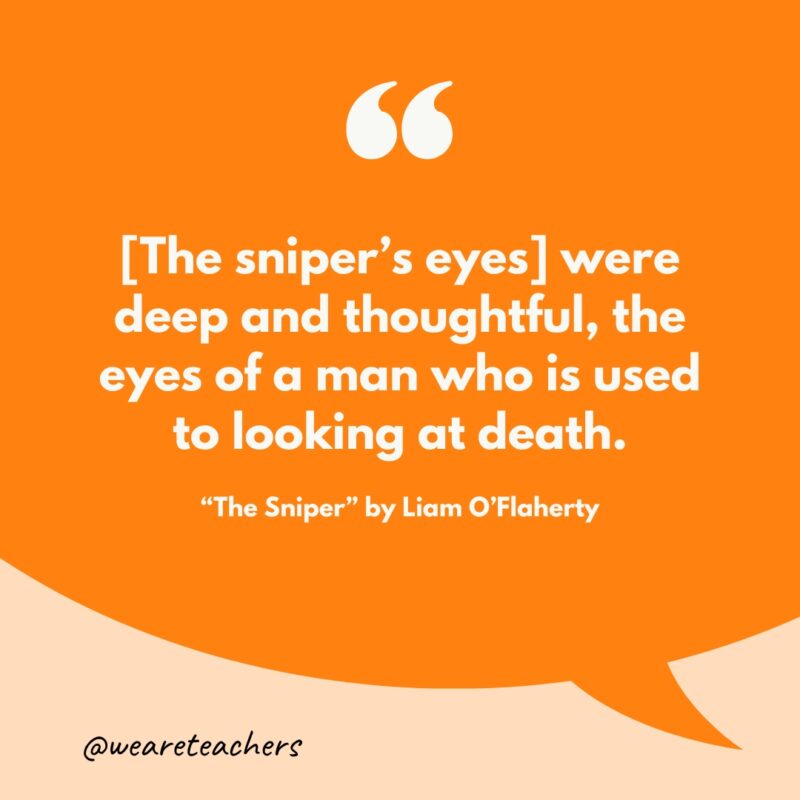
Why we love it: It’s a story that illustrates the pain and loss of war.
34. The Lady or the Tiger? by Frank Stockton*
“It mattered not that he might already possess a wife and family, or that his affections might be engaged upon an object of his own selection; the king allowed no such subordinate arrangements to interfere with his great scheme of retribution and reward.”
Why we love it: This story has a clear cause-and-effect structure that you can use to show how actions have consequences.
35. The Black Cat by Edgar Allan Poe*
“Yet, mad I am not—and very surely do I not dream.”
Why we love it: This is one of the classic Poe short stories for high school about madness. It’s a good one to use to introduce students to classic short stories, or to Edgar Allan Poe.
36. The Celebrated Jumping Frog of Calaveras County by Mark Twain*
“Smiley said all a frog wanted was education, and he could do ‘most anything’—and I believe him.”
Why we love it: A Mark Twain story about a man who bets on anything. Use this next time a student says “Bet!” to you.
37. The Metamorphosis by Franz Kafka*
“One morning, when Gregor Samsa woke from troubled dreams, he found himself transformed in his bed into a horrible vermin.”
Why we love it: Read this story for symbolism, as the main character turns into an insect overnight. It’s an excellent story that illustrates alienation and loneliness.
38. Young Goodman Brown by Nathaniel Hawthorne*
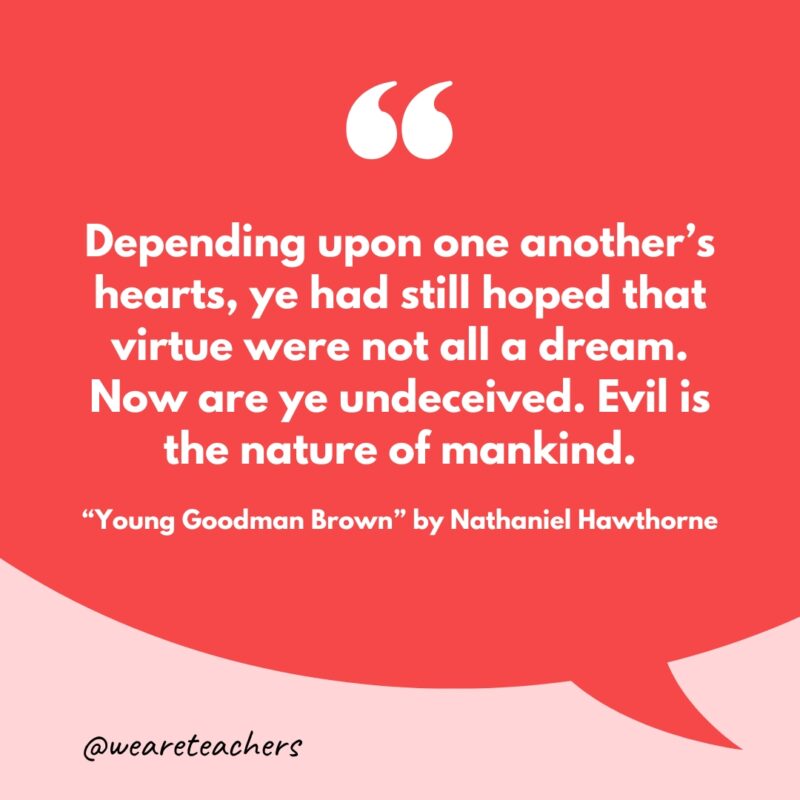
Why I love it: A great read for American literature that explores the nature of humanity and questions of faith.
39. Through the Tunnel by Doris Lessing
“They were of that coast; all of them were burned smooth dark brown and speaking a language he did not understand. To be with them, of them, was a craving that filled his whole body.”
Why we love it: The story focuses on overcoming limitations while an 11-year-old trains to swim through an underwater hole in a rock.
40. The Ice Palace by F. Scott Fitzgerald*
“Up in her bedroom window Sally Carrol Happer rested her nineteen-year-old chin on a fifty-two-year-old sill and watched Clark Darrow’s ancient Ford turn the corner.”
Why we love it: Fitzgerald was gifted in writing about tension in love. This story is about the tension between lovers from the North and South. Read it for the story and the poetic language of Fitzgerald.
41. Birthday Party by Katharine Brush
“There was nothing conspicuous about them, nothing particularly noticeable, until the end of their meal, when it suddenly became obvious that this was an Occasion—in fact, the husband’s birthday, and the wife had planned a little surprise for him.”
Why we love it: This is a very quick read and manages to pack a punch in a small word count.
42. Thank You, Ma’am by Langston Hughes
“You ought to be my son. I would teach you right from wrong.”
Why we love it: The story is relatable and sends an important message.
43. Girl by Jamaica Kincaid

Why we love it: It’s a message from a mother to a daughter on how to behave.
43. The Pie by Gary Soto
“Once, at the German Market, I stood before a rack of pies, my sweet tooth gleaming and the juice of guilt wetting my underarms. I nearly wept.”
Why we love it: This is one of the best short stories for high school about the strength and power of guilt in the presence of childhood and into an adulthood.
44. Sticks by George Saunders
“The pole was Dad’s only concession to glee.”
Why we love it: This super-short story is about a father’s tradition of decorating a pole in the yard and all that the pole represents.
45. Marigolds by Eugenia Collier
“For one does not have to be ignorant and poor to find that one’s life is barren as the dusty yards of our town.”
Why we love it: This is a story about realizing that we’re growing up. It’s a great story that students can immediately relate to.
46. The Pedestrian by Ray Bradbury
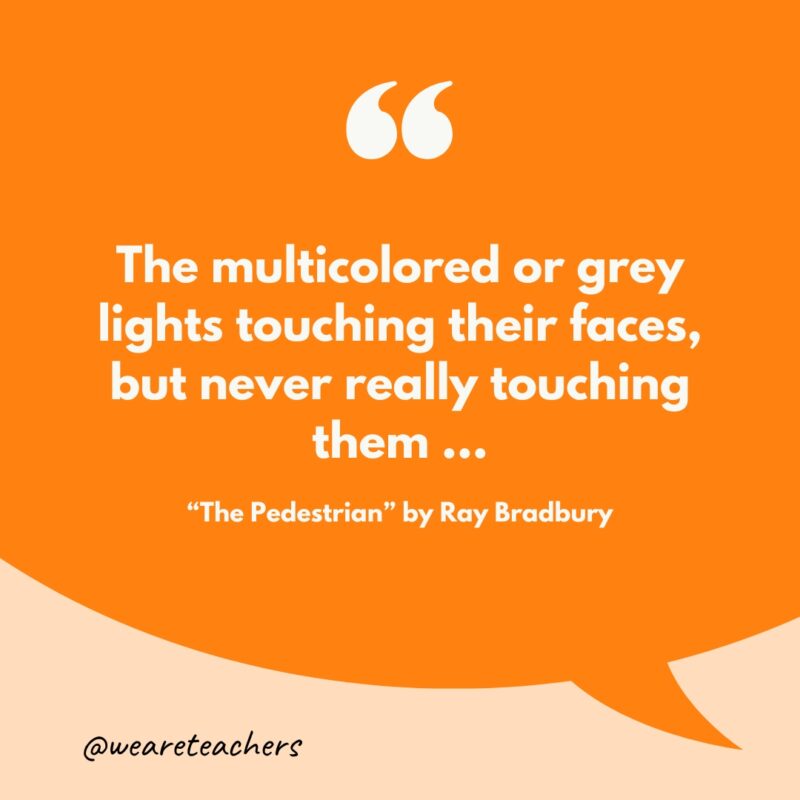
Why we love it: This story takes place in 2053 and Ray Bradbury has a way of making the future feel like the present. In a story written long ago, he reminds us how important it is to not lose our humanity.
47. The Stolen Party by Liliana Heker
“She was so pleased with the compliment that a while later, when her mother came to fetch her, that was the first thing she told her.”
Why we love it: This story lets us view a party through a child’s eyes and a mother’s desire to protect her daughter’s heart.
48. Through the Tunnel by Doris Lessing
“He would do it if it killed him, he said defiantly to himself.”
Why we love it: This is a story that is rich in symbolism and beautifully illustrates the transition from childhood to adulthood.
49. The Wretched and the Beautiful by E. Lily Yu
“‘Come out where we can see you,’ the policeman said. The rest of us were glad that someone confident and capable, someone who was not us, was handling the matter.”
Why we love it: While this story involves aliens, it asks readers to think about what it means to be human. There is also great symbolism in this story.
50. Cooking Time by Anita Roy
“At that moment, all I felt was angry. I’d always known that Mandy’s obsession would get us into trouble. But would she listen? Never.”
Why we love it: This is a story that is set in a dystopian future where the food has been replaced by a supplement. It’s a unique take on a dystopian world as it involves a cooking show and trying to change the way the world operates.
51. He — Y, Come On Ou — t! by Shinichi Hoshi, translated by Stanleigh Jones
“Whatever one wished to discard, the hole accepted it all. The hole cleansed the city of its filth. …”
Why we love it: This is a story about a Japanese village discovering a mysterious hole and illustrates what happens when people behave selfishly.
52. The Gift of the Magi by O. Henry*
“One dollar and eighty-seven cents. That was all. And sixty cents of it was in pennies. Pennies saved one and two at a time by bulldozing the grocer and the vegetable man and the butcher until one’s cheeks burned with the silent imputation of parsimony that such close dealing implied. Three times Della counted it. One dollar and eighty-seven cents. And the next day would be Christmas.”
Why we love it: The story starts in a shabby apartment on Christmas Eve and works up to themes of inner worth, love, and the subjective value that we place on objects.
53. Desiree’s Baby by Kate Chopin*
“It made her laugh to think of Désirée with a baby. Why, it seemed but yesterday that Désirée was little more than a baby herself; when Monsieur in riding through the gateway of Valmondé had found her lying asleep in the shadow of the big stone pillar.”
Why we love it: Chopin is known for humor, but this story has a serious subject. The main character is raised on a rural plantation in pre-Civil War Louisiana. But, when she grows up and has a child of her own, her background becomes problematic. This story grapples with the hypocrisy and exploitation in societies built on racial discrimination.
54. A Journey by Cart or In the Cart by Anton Checkhov*
“Maria Vasilievna had been a school teacher for thirty years, and it would have been impossible for her to count the number of times she had driven to town for her salary, and returned home as she was doing now. It mattered not to her whether the season were spring, as now, or winter, or autumn with darkness and rain; she invariably longed for one thing and one thing only: a speedy end to her journey.”
Why we love it: It’s classic Chekhov–a story centered around a journey that you, the reader, drop into and are swept along by. This is a wonderful example of Chekhov’s poetry prose. It is a longer short story, so either choose a selection or dedicate more time to it.
55. Hills like White Elephants by Ernest Hemingway*
“The hills across the valley of the Ebro were long and white. On this side there was no shade and no trees and the station was between two lines of rails in the sun.”
Why we love it: Hemingway is another must read for students. In this story, even the setting, a railroad station, has significance. The story is also a study in contrasts, with white hills and the barren valley, life and death. One thing to know: this is a story that involves a woman thinking about whether or not to have an abortion.
56. The Diamond Necklace by Guy de Maupassant*
“The girl was one of those pretty and charming young creatures who sometimes are born, as if by a slip of fate, into a family of clerks. She had no dowry, no expectations, no way of being known, understood, loved, married by any rich and distinguished man; so she let herself be married to a little clerk of the Ministry of Public Instruction.”
Why we love it: The main character is focused on material possessions but learns an important lesson when an unfortunate accident happens to him. It’s a great example of the short story form, and a way for students to learn about what life was like in the 19th century.
57. The Oval Portrait by Edgar Allan Poe*
“Long, long I read—and devoutly, devotedly I gazed. Rapidly and gloriously the hours flew by and the deep midnight came. The position of the candelabrum displeased me, and outreaching my hand with difficulty, rather than disturb my slumbering valet, I placed it so as to throw its rays more fully upon the book.”
Why we love it: Edgar Allan Poe never disappoints. This story has all the hallmarks of a Poe story–Gothic, macabre, and gloomy with a semi-delirious narrator. This would be a great story to assign as extra reading for students who love suspense or Poe.
58. The Eyes Have It by Philip K. Dick*
“It was quite by accident I discovered this incredible invasion of Earth by lifeforms from another planet. As yet, I haven’t done anything about it; I can’t think of anything to do.”
Why we love it: Dick imagines what it would be like if aliens invaded Earth, but no one listened. The story is also packed with language that shows how weird English can be when taken literally.
59. Markheim by Robert Louis Stevenson*
“Yes,” said the dealer, “our windfalls are of various kinds. Some customers are ignorant, and then I touch a dividend on my superior knowledge. Some are dishonest,” and here he held up the candle, so that the light fell strongly on his visitor, “and in that case,” he continued, “I profit by my virtue.”
Why we love it: Like much of Stevenson’s work, Markheim does a deep dive into the dichotomy of good and evil, which means there’s a lot to discuss.
60. The Triumph of Night by Edith Wharton*
“It was clear that the sleigh from Weymore had not come; and the shivering young traveller from Boston, who had so confidently counted on jumping into it when he left the train at Northridge Junction, found himself standing alone on the open platform, exposed to the full assault of night-fall and winter.”
Why we love it: This story is a mystery with supernatural elements. It’s not a horror story, but Wharton uses characterization to analyze motives and describe the supernatural elements in sparse language that will require students to use their imaginations.
61. A Descent into the Maelstrom by Edgar Allan Poe*
“In truth so deeply was I excited by the perilous position of my companion, that I fell at full length upon the ground, clung to the shrubs around me, and dared not even glance upward at the sky—while I struggled in vain to divest myself of the idea that the very foundations of the mountain were in danger from the fury of the winds.”
Why we love it: Well, we love a lot of Edgar Allan Poe’s work. This story takes a natural phenomenon-a maelstrom or a whirlpool-and uses it to create a story that lends itself to multiple interpretations. See how many conclusions students can come to.
62. Heart of Youth by Walter J. Muilenburg*
“The boy on the cultivator straightened as the horses walked from the soft, spongy ground of the cornfield to the firmer turf at the side of the road. He spoke sharply to the plodding team and turned the cultivator around, lowering the blades for another row. Then, when the horses had fallen into a slow walk, he slouched down, and with bent head watched the hills of young corn pass beneath him.”
Why we love it: A simple story about a teenage boy, this story also gives context for what life was like in the early 1900s with themes that students can relate to.
63. How the Widow Won the Deacon by William James Lampton*
“Of course the Widow Stimson never tried to win Deacon Hawkins, nor any other man, for that matter. A widow doesn’t have to try to win a man; she wins without trying.”
Why we love it: In Victorian Era, women had limited rights and lost even more rights when they were married. In this story, Lampton turns this idea on its head as a widow wins over a deacon. This story comes from a book of humorous American short stories, and it doesn’t take much to see how authors can use the short story to make a humorous point about society.
64. Antaeus by Frank Bicknell*
“I am not sure that it is usual to confer upon steam-rollers the dignity of a name, but my friend had one, and I read it on the neat, black-lettered brass plate affixed to the side of his boiler, near the smoke-stack. This, I take it, was the nearest practicable approach to hanging a locket about his neck that could be managed, and I have always felt grateful to his unknown sponsors for their little act of consideration.”
Why we love it: This story comes from a book of adventure stories and takes place on the American railroad, a wonderful way to talk about plot and symbolism.
65. Why the Sea is Salt, a Norse Myth*
Once on a time, but it was a long, long time ago, there were two brothers, one rich and one poor. “Now, one Christmas eve, the poor one hadn’t so much as a crumb in the house, either of meat or bread, so he went to his brother to ask him for something to keep Christmas with, in God’s name. It was not the first time his brother had been forced to help him, and you may fancy he wasn’t very glad to see his face…”
Why we love it: Short stories include myths and legends. Read this Norse myth to learn more about this culture and how they thought about the origins of the sea. And, compare Norse myths with other culture’s tales.
66. Daedalus and Icarus*
“Daedalus of Athens was a son of Metion, grandson of Erectheus. He was the most skillful man of his time–an architect, sculptor, and stone worker…But skillful, zealous, and active as he was in his work, he had vices which brought him into trouble.”
Why we love it: Use short stories to reintroduce high schoolers to myths. If they are familiar with these myths, how does their additional life experience impact their understanding of each story?
67. A Slander by Anton Chekhov*
Vankin’s sincerity did not admit of doubt. It was evidently not he who was the author of the slander.
“But who, then, who?” Ahineev wondered, going over all his acquaintences in his mind and beating himself on the breast. “Who then?”
Who then? We, too, ask the reader.”
Why we love it: In this story, a schoolmaster is upset when a rumor spreads about him. The topic is totally relatable and will inspire discussion about how some themes change but never die.
68. The Boscombe Valley Mystery by Arthur Conan Doyle*
“We were seated at breakfast one morning, my wife and I, when the maid brought in a telegram. It was from Sherlock Holmes and ran in this way: ‘Have you a couple of days to spare? Have just been wired for from the west of England in connection with Boscombe Valley tragedy. Shall be glad if you will come with me. Air and scenery perfect. Leave Paddington by the 11:15.’”
Why we love it: The adventures of Sherlock Holmes are a great way to introduce students to detective stories, or to invite them to discover Conan Doyle, the master of mysteries. In this story, a man is murdered and his estranged son is the suspect.
69. Bartleby the Scrivener by Herman Melville*
“Imprimis: I am a man who, from his youth upwards, has been filled with a profound conviction that the easiest way of life is the best. Hence, though I belong to a profession proverbially energetic and nervous, even to turbulence, at times, yet nothing of that sort have I ever suffered to invade my peace.”
Why we love it: Students may already know Melville for Moby Dick, so this story about a clerk who, after being hired for a job refuses to do it, is another perspective on Melville.
70. A Warrior’s Daughter by Zitkala-Sa*
“In the afternoon shadow of a large tepee, with red-painted smoke lapels, sat a warrior father with crossed shins. His head was so poised that his eye swept easily the vast level land to the eastern horizon line.”
Why we love it: This Native American story tells the narrative of a woman, Tusee, who takes action against an enemy tribe when her love is captured. It’s a love story written by an author from the Dakota.
71. The Adventure of the Speckled Band by Arthur Conan Doyle*
“It was early in April in the year ’83 that I woke one morning to find Sherlock Holmes standing, fully dressed, by the side of my bed.”
Why we love it: Another Sherlock Holmes story. In this story, the main character’s twin sister died two years before, but now she fears for her life. Suspenseful!
72. The One Thousand Dozen by Jack London*
“David Rasmunsen was a hustler, and, like many a greater man, a man of the one idea. Wherefore, when the clarion call of the North rang on his ear, he conceived an adventure in eggs and bent all his energy to its achievement.”
Why we love it: This story, originally published in 1903, takes a humorous spin on the westward expansion that London loved to write about. In this story, a man tries to make money by transporting eggs from San Francisco to Dawson, but his cargo is constantly in danger.
73. Hansel and Grethel by the Grimm Brothers*
“Once upon a time there dwelt near a large wood a poor woodcutter, with his wife and two children by his former marriage, a little boy called Hansel, and a girl named Grethel.”
Why we love it: High schoolers have the background knowledge to tackle Grimms fairy tales in their original versions. Read Hansel and Gretel and discuss what makes a children’s story? Why might people write such, well, grim, stories for kids?
74. The Box of Robbers by L. Frank Baum*
“No one intended to leave Martha alone that afternoon, but it happened that everyone was called away, for one reason or another.”
Why we love it: Students are already familiar with L. Frank Baum’s most famous story, The Wizard of Oz, but Baum also wrote many short stories in his career. Reading lesser known works by well known writers gives students a deeper perspective about these personalities.
75. The Willows by Algernon Blackwood*
“After leaving Vienna, and long before you come to Buda-Pesth, the Danube enters a region of singular loneliness and desolation, where its waters spread away on all sides regardless of a main channel, and the country becomes a swamp for miles upon miles, covered by a vast sea of low willow-bushes.”
Why we love it: Algernon Blackwood was a prolific writer and well known for his supernatural and ghost stories. The Willows had an impact on other writers, like H. P. Lovecraft who thought it was the finest ghost story in English literature.










